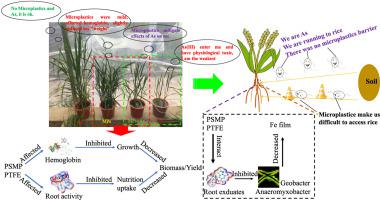Journal of Hazardous Materials ( IF 12.2 ) Pub Date : 2021-07-19 , DOI: 10.1016/j.jhazmat.2021.126694 Youming Dong 1 , Qiongli Bao 2 , Minling Gao 3 , Weiwen Qiu 4 , Zhengguo Song 3

|
Although the compound pollution of microplastics and arsenic (As) in paddy soil can affect the growth and quality of rice, relevant research on this phenomenon was limited. Therefore, we combined a pot experiment with computational chemistry to explore the effects and mechanism of polystyrene (PSMP) and polytetrafluoroethylene (PTFE) microplastics on As bioavailability. PSMP and PTFE interacted with rice root exudates through van der Waals forces, approached the rice root system, inhibited root activity, reduced the relative abundance of Geobacteria and Anaeromyxobacter, and consequently reduced the iron plaques on the root surfaces. Consequently, As uptake by the rice was inhibited. PSMP and PTFE reduced the hemoglobin content by directly destroying its tertiary structure, thereby retarding rice growth. In contrast, As increased the hemoglobin content by inducing reactive oxygen species in rice. Under the influence of PSMP, PTFE, and As, the activities of soluble starch synthase and pyrophosphorylase in rice grains were inhibited, and starch accumulation decreased. Thus, PSMP, PTFE, and As reduced rice biomass and yield owing to their physiological toxicity and adverse impacts on root activity. Grain yields in soil with an As content of 86.3 mg·kg–1, 0.5% small particle-sized PSMP, and 0.5% small particle-sized PTFE decreased by 30.7%, 20.6%, and 19.4%, respectively, compared to the control. This study determined the comprehensive mechanism through which PSMP and PTFE affect As bioavailability, which is critical for managing rice biomass and low yields in As and microplastic co-contaminated soil.
中文翻译:

籼稻(Oryza sativa L.)微塑料和砷共污染的新机制研究
水稻土中微塑料与砷(As)的复合污染虽然会影响水稻的生长和品质,但相关研究有限。因此,我们将盆栽实验与计算化学相结合,探索聚苯乙烯 (PSMP) 和聚四氟乙烯 (PTFE) 微塑料对砷生物利用度的影响和机制。PSMP和PTFE通过范德华力与水稻根系分泌物相互作用,接近水稻根系,抑制根系活动,降低地杆菌和厌氧菌的相对丰度,从而减少了牙根表面的铁斑。因此,水稻对砷的吸收受到抑制。PSMP 和 PTFE 通过直接破坏其三级结构来降低血红蛋白含量,从而阻碍水稻生长。相比之下,As 通过诱导水稻中的活性氧来增加血红蛋白含量。在PSMP、PTFE、As的作用下,水稻籽粒可溶性淀粉合酶和焦磷酸化酶活性受到抑制,淀粉积累减少。因此,由于 PSMP、PTFE 和 As 的生理毒性和对根活动的不利影响,它们降低了水稻的生物量和产量。砷含量为 86.3 mg·kg –1 的土壤中的谷物产量与对照相比,0.5% 小颗粒 PSMP 和 0.5% 小颗粒 PTFE 分别降低了 30.7%、20.6% 和 19.4%。该研究确定了 PSMP 和 PTFE 影响砷生物有效性的综合机制,这对于管理砷和微塑料共污染土壤中的水稻生物量和低产量至关重要。











































 京公网安备 11010802027423号
京公网安备 11010802027423号